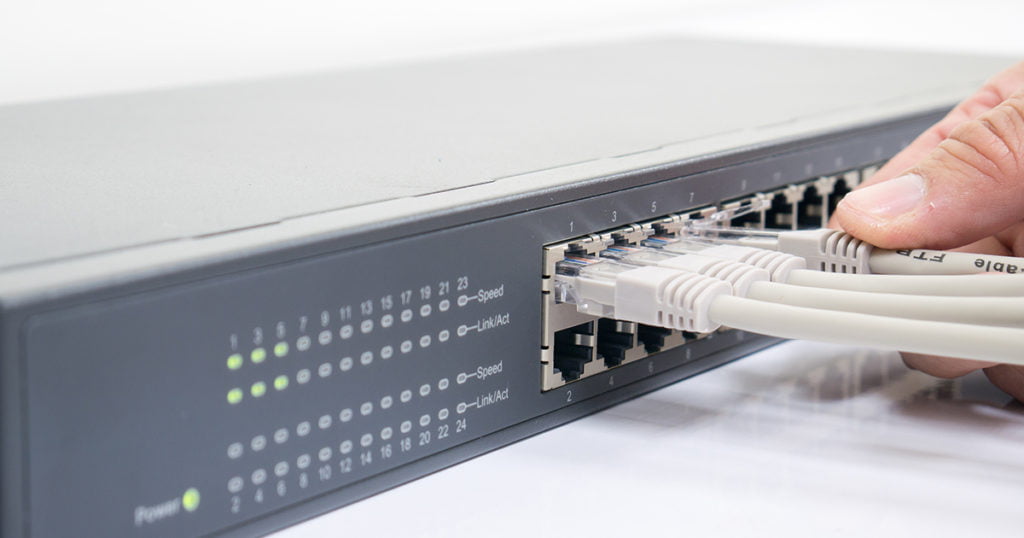Six Factors to Consider When Purchasing a Network Switch

Network switches are an essential part of any network infrastructure. They allow devices on the network to communicate with each other, and they play a crucial role in ensuring that data flows smoothly between different parts of the network.
When choosing a switch, there are several factors to consider, including the type of traffic the switch will be used for, the size and configuration of the network it will be installed on, and the budget available.
What is a Network Switch, and What Does it Do?
A network switch is a device that forwards and filters data packets between two or more computer networks. A switch is distinct from a hub, which repeats all received messages to connected devices.
In contrast, a switch forwards packets only to the destination device specified by the packet’s MAC address. Switches are one of the most common networking equipment in a business setting.
Switches play a vital role in networking by creating separate collision domains for each connected device. This prevents two devices from transmitting data simultaneously and causing a collision, leading to lost data and network congestion.
Switches also allow for full-duplex communication, doubling the transmission speed over a traditional half-duplex network.
Six Factors to Consider When Purchasing a Network Switch
When purchasing a network switch, several factors need to be considered.
Amount of Traffic Passing Through the Switch
One of the most important factors to consider when purchasing a network switch is the amount of traffic passing through it. If the switch is going to be used for light traffic, then a less expensive model may suffice. However, if the switch will handle a lot of traffic, then a more robust and costly model like Aruba 6100 JL675A will be necessary.
How to Determine the Amount of Traffic that will Pass Through the Switch?
There are a few ways to determine the amount of traffic that will pass through the switch.
- Estimate the Amount of Data Needed: Begin by estimating the amount of data that will need to be sent and received over the network. This can be done by looking at past usage patterns or estimating future needs.
- Check the Application Requirements: Some applications may have specific requirements for the bandwidth they need.
- Determine the Maximum Throughput: Once you know the amount of traffic that will pass through the switch, you can determine the maximum throughput required. This can be done by multiplying the estimated data rate by 1.5. For example, if you expect 10 Mb/s (megabits per second) of traffic, you would need a switch with a maximum throughput of 15 Mb/s.
Number of Devices Connected to the Switch
Another vital factor is the number of devices connected to the switch. A switch with 24 ports will be able to connect to more devices than a switch with eight ports. However, a lower port density may be sufficient if most of the devices connected to the switch do not use all their available bandwidth.
Bandwidth Requirements of Connected Devices
It is also essential to consider the bandwidth requirements of the devices connected to the switch. If the devices are transferring large amounts of data, then a switch with a higher bandwidth capacity will be necessary.
Port Density
The port density of a switch is the number of ports per unit of physical space. A high port density is essential if the switch is installed in a small space, such as a server rack.
Management Features
Another factor to consider when purchasing a network switch is the management features offered by the manufacturer.
- Basic Management Features: If your network is small and you do not need advanced features, a switch with basic management capabilities will suffice.
- Advanced Management Features: If your network is large or you need advanced features such as remote management and monitoring, a switch with advanced management capabilities will be necessary.
Budget
Finally, it is crucial to consider the budget available for the switch purchase. Switches can range in price from a few hundred dollars to several thousand, so choosing a model that fits within the budget is essential.
By considering all of these factors, you can be sure to purchase the best network switch for your needs.
The Benefits of Using a Network Switch
A network switch is a vital part of any network.
- Allows Multiple Devices to Connect to the Network and Share Data: One of the main benefits of using a network switch is that it will enable multiple devices to connect to the network and share data.
- Improves Network Performance: Another benefit of using a network switch is that it can improve network performance by reducing congestion and increasing bandwidth.
- Makes Network Management Easier: A final benefit of using a network switch is that it makes network management easier by providing a central point to manage all the devices on the network.
Switches come in various sizes and can be used for small homes or large enterprise networks. By considering the factors mentioned above, you can be sure to purchase the best Aruba switch for your needs.
Common Problems with Network Switches and How to Solve Them
One of the most common problems with network switches is port contention.
Port Contention
Port contention occurs when two or more devices attempt to use the same port on the switch. This can cause data collisions and result in decreased network performance.
To solve this problem, you can upgrade to a switch with more ports or connect the devices to different ports on the switch.
Spanning Tree Loops
Spanning tree loops occur when there is more than one path between two devices on the network. This can cause data packets to be sent in circles, resulting in decreased network performance.
To solve this problem, you can disable the spanning tree on the switch or use a different type of network topology.
If you are experiencing any other problems with your network switch, you can consult the user manual or contact the manufacturer for support.
Network switches are an essential part of any network. By considering the factors mentioned above, you can be sure to purchase the best switch for your needs. If you are experiencing any problems with your switch, you can consult the user manual or contact the manufacturer for support.
Conclusion
There are several things to think about while purchasing a network switch. The traffic your network will have is the most essential of these factors. You’ll also need to consider how many devices you will connect to the switch and their data requirements. Other elements to consider include port density, management capabilities, and budget.
By analyzing these variables, you can ensure that you receive the best switch for your needs.





